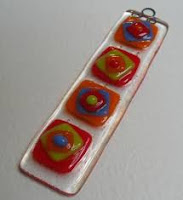"I'd like advice about annealing. I'm about to start a series that are to be wall hangings. The outside 100mm is only 3mm thick and the centre is 6mm and occasionally 9mm thick. They are going to be A3 and A2 size. I intend to tack fuse. I'm happy to experiment with the tack fuse temperature (I think about 677°C). How long should I anneal it? That's my question."
Determining the Tack Temperature
The high end of slumping, and the low end of sintering is 677°C/1252°F. Unless your kiln fires very hot, this is not hot enough for a tack fuse. Make some small-scale mock-ups in clear. Schedule the kiln to a full fuse on a rate not more than 300°C/540°F per hour. Peek into the kiln at 10°C/18°F intervals from 677°C/1252°F upwards. When you see the profile you want, note the temperature. When scheduling the tack firing, reduce the target temperature by 5C and add a 10-15 minute soak to get approximately the same result as you observed in the test firing.
Scheduling to Avoid Dog Boning
You have a border of 100mm/4.0” that is only one layer thick. This has the risk of becoming irregular at the corners compared to the sides (dog boning). To avoid dog boning of the 3mm base, the lowest temperature you can use is important. This is the main reason for the peeking – to determine the temperature at which dog boning begins. It is not only the degree of rounding of the edges you are looking for, but also the degree of retraction of the sides of the piece. When you note the beginning of the dog boning, you have reached just beyond the temperature to avoid that.
You will of course have to set the mock-up in such a way that you can see at least one side through the peep hole. The front will not give you accurate information, but if the side is in your sight line, you will see when it begins to deform. This peeking will keep you occupied for about 3/4 hour. Make sure you have gridded paper and pencil to hand to record information in between peeking.
It may be that the glass has not begun to round when the dog boning starts. In this case you will need to make the border larger and cut the glass back to straight lines. 20-30mm/0.75-1.125” extra all around will make it easy to trim the excess cleanly.
Annealing
I do not know the degree of tack you are aiming to achieve. It is important to the scheduling of the anneal. A sharp tack profile will require annealing for longer than a contour profile for your thicknesses. These suggestions assume the total height is 9mm/0.375”. If it higher, the soak and cooling times and rates will be longer and slower.
A sharp tack profile
will need:
- Annealing for 270 minutes (4.5 hours) with a cool rate of:
First 55°C/100°F cool at 13°C/23°F per hour.Second 55°C/100°F cool at 23°C/41°F per hour.Final cool at 78°C/140°F per hour to room temperature.
A rounded tack
profile will need:
- Annealing for 180 minutes (3 hours) with a cool rate of:
- First 55°C/100°F cool at 25°C /45°F per hour
- Second 55°C/100°F cool at 45°C /81°F per hour
- Final cool at 150°C /270°F per hour to room temperature.
A contour tack
profile will need:
- Annealing for 120 minutes (2 hours) with a cool rate of:
- First 55°C/120°F cool at 55°C /99°F per hour
- Second 55°C/100°F cool at 99°C /178°F per hour
- Final cool at 330°C /216°F per hour to room temperature.
More detailed information is in my eBook Low Temperature Kilnforming, An Evidence-Based approach to Scheduling. It is available from VerrierStudio on Etsy or through Bullseye.
It is not cheap, but at 300pp worth it (in my opinion!). It discusses the three profiles of tack fusing - sharp, rounded, contour. It also deals with slumping, sintering, freeze and fuse, and bas relief or texture mould firings. The method for determining schedules is outlined and specific sample schedules are listed.

No comments:
Post a Comment